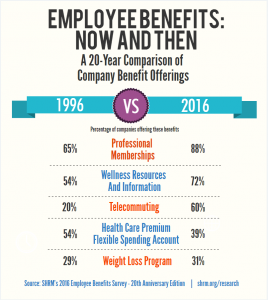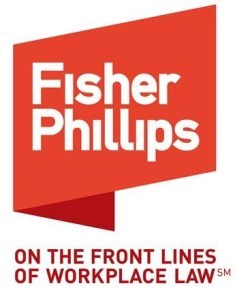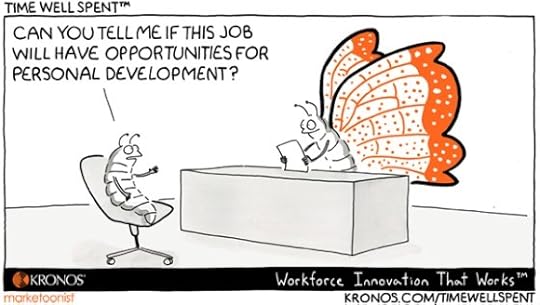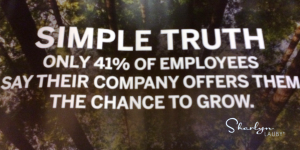Sharlyn J. Lauby's Blog, page 149
October 9, 2016
Everyone Has the Ability To Be an Influencer
A few months ago, I had the opportunity to hear change leadership expert Cheryl Cran at SilkRoad’s Connections Conference. If you ever have the chance to hear her speak, she’s definitely worth your time.
During her session, she made the comment that “Leadership is the ability to influence others.” I’ve been saying this for years as well…so I tweeted it out. One of the reasons I like this definition of leadership is because it also implies that everyone is a leader. Leadership is not designated for a certain group of people within the organization. Well, after I hit send on my tweet, I received a response.
Everyone can influence other people? Definitely not! Leadership is more than that anyway.
It’s easy to think that leadership consists of a whole bunch of things. I’ve done it myself. But leadership isn’t management. It’s also not the same as entrepreneurship. Leadership is one thing – influence. Granted management, entrepreneurship, and leadership work very well together. That’s what can add a layer of complexity to the leadership conversation. I’ve been thinking about this comment for a while, so I wanted to dissect it a little.
Leadership is the ability to lead, which is “to direct on a course of action or in a direction.”
Influence is defined as “the capacity to have an effect on the character, development, or behavior of someone or something.”
So it seems logical that if you’re able to influence, then you can lead. Now this isn’t to say that influence is easy, because it’s not. Which is why leadership isn’t easy. But anyone can be an influencer. Here are some real life examples, some you may know, and some maybe not:
Erin Brockovich wasn’t a lawyer when she built a case against the Pacific Gas and Electric Company of California. But did she influence people? Yes. And to the extent that Julia Roberts portrayed her in a movie.
Alexandra Flynn Scott was diagnosed with pediatric cancer two days before her first birthday. Despite her health issues, she decided to open a lemonade stand. Alex’s Lemonade Stand for Childhood Cancer raised more than $1 million dollars toward finding a cure until the disease took her life. Since then, her parents have started a foundation in her name and raised close to $20 million dollars for awareness, education and research. Was Alex an influencer? You bet. And she continues to influence.
Miles Scott is a cancer survivor who wanted to celebrate completing his treatments by being “Batkid” for the day. The Make-A-Wish Foundation in San Francisco organized one of the most elaborate wishes ever, turning San Francisco into Gotham City, complete with an actor dressed as Batman, a Batmobile, and The Riddler villian. The city’s newspaper changed its name for the day, the Mayor gave Batkid the keys to the city, and over 10,000 residents crowded the streets to cheer. A documentary has been released about it. Did Miles influence a few people? Yes, he did.
There are thousands of stories like this. And there are stories like this in the business world too. Think of the people who enter the Lay’s potato chip contest and influence new flavors. Or the kid who makes the news by building a clock and gets an invite to meet Mark Zuckerberg, CEO of Facebook. That’s influence.
It’s true that influence might come easier when you’re famous or have a certain job title. But it doesn’t mean that influence isn’t possible. And that’s the point. Influence is possible at every level of the organization. The question becomes are organizations putting themselves in the position where they can take advantage of it.
Image taken by Sharlyn Lauby at an adventure in Chicago, IL
The post Everyone Has the Ability To Be an Influencer appeared first on hr bartender.






October 7, 2016
Employee Benefits: Then and Now [infographic] – Friday Distraction
We talk a lot about how the workplace is changing. And how as a result, we need to manage employees differently, use newer technologies, etc. But what about employee benefits?
For the past twenty years, the Society for Human Resource Management (SHRM) has been publishing an employee benefits survey. This year, they decided to compare the benefits of twenty years ago and today. Evren Esen, director of survey programs at SHRM, shares some of the interesting results. “The biggest surprise was that, overall, while the number and types of benefits offerings from organizations has grown over the past 20 years, there have not been many major changes in terms of coverage of core employee benefits. Benefits such as health care, retirement planning and employee assistance programs are offered to employees at the same level as in 1996.”
The good news is that employers are listening to demands for better work/life balance with increased telecommuting, flextime and other accommodations. Since 1996, the percentage of organizations offering telecommuting has increased threefold (from 20 to 60 percent), and the percentage offering telecommuting on an ad hoc basis has increased from 45 percent in 2012 to 56 percent in 2016.
If you want to learn more, the full survey is available online. You can also get other survey findings by following @SHRM_Research on Twitter.
I understand the core benefits Evren mentioned are expensive to an organization’s bottom-line. But if we want to attract, engage, and retain the best talent, the company’s benefit package needs to show it. That doesn’t mean simply adding a foosball table or a “Bring Your Dog to Work” day. It means adding or enhancing core benefits.
The post Employee Benefits: Then and Now [infographic] – Friday Distraction appeared first on hr bartender.






October 6, 2016
Using VUCA to Process Organizational Change
During this year’s WorkHuman Conference, hosted by Globoforce, I learned a new acronym – VUCA. It stands for volatility, uncertainty, complexity, and ambiguity. Wikipedia says it was introduced by the U.S. Army in the 1990s. In recent years, it’s been used in strategic leadership conversations. Basically, it means the world is a little wild and crazy. I’m sure we’ve all felt that way about our business lives at one time or another.
The Society for Human Resource Management (SHRM) recently posted a framework for addressing VUCA situations. It’s worth checking out. There are several ways that VUCA finds its way into our professional lives:
V = volatility. The challenge is focused on making organizational change and the speed of change.
U = uncertainty. This is about lack of predictability and staying aware of what’s happening.
C = complexity. It’s understanding the cause and effect of issues facing the business.
A = ambiguity. It presents opportunities to misread a situation or confuse messaging.
The idea isn’t to use VUCA to replace strategy. It’s to consider it a part of strategy preparedness. Harvard Business Review published a series of articles on VUCA a few years ago, outlining some of the activities you can do when faced with a VUCA challenge or situation.
In a volatile situation, communication is essential. The organization will be looking for knowledge and information. The more people know, the better they can process the change.
With uncertain situations, demonstrate flexibility. While the strategy isn’t predicable, it shows that it can be handled. And, seek out different perspectives which might help reframe the company’s point-of-view in managing change.
For complex situations, take time to think and process the dynamics of the issue. It might offer new insights or options. Also, bring in new collaborators to add a fresh perspective.
Lastly, when ambiguous situations arise, listen actively to the details then consider taking a scientific approach of hypothesizing and testing experiments. It can logically narrow options and surface discoveries.
I could see VUCA being used to triage challenges that the organization faces regularly. As in, we have Challenge A. Is it volatile? Yes. Let’s make sure we have a good communication strategy in place. VUCA might also be a great tool for employees to use in the operation and relatively easy to teach them (versus some other more complicated models.)
The business world continues to move faster and change constantly. As business professionals, we have to find a way to process that change. VUCA might help us understand that communication, flexibility, collaboration, and experimentation are the way.
Image created by Sharlyn Lauby since nothing really goes with VUCA
The post Using VUCA to Process Organizational Change appeared first on hr bartender.






October 4, 2016
10 Tips for Effective Goal Setting
(Editor’s Note: Today’s post is brought to you by our friends at SilkRoad, a global leader in cloud-based talent management solutions. They have introduced the “SilkRoad Talent Talk Podcast,” which identifies and discusses current trends in HR technology and the most pressing issues facing organizations. The podcast airs on the 1st and 15th of each month – be sure to check it out. Enjoy the post!)
I’ve always worked in organizations where this time of year was budget time. We spent hours in meetings talking about the goals we wanted to accomplish in the upcoming year (and how to fund those projects.)
The conversations we had about company goals eventually became department goals. Then of course, they became individual goals. While goals cascaded down the organization, it was still important for employees to feel connected and invested in the goals they needed to accomplish.
Even as a consultant today, I still create a budget and goals. The size of the company doesn’t matter. I find that I do my best work when I have goals. As I’m working on my 2017 goals, I thought it would be valuable to document the tips I’ve learned over the years.
Set relevant goals that align with the organization. If you want goals to have impact, they need to align with the business. Ask yourself, “How does this goal help the company accomplish its strategy or mission?” It doesn’t have to always be a direct alignment, but it does need to connect.
Get buy-in from management. Goals usually involve a change. That’s not a bad thing. It means the company is going from XX to YY as a result of accomplishing a goal. For goals to work, they need resources. That means management must support them.
Document goals (on paper, in a journal, or online). I’ve found the way to stay focused on goals is to see them regularly. Goals should not be tucked away in a binder on a shelf. They can be tacked to a cubicle, written in a daily journal, or better yet, noted in a software solution.
Phase goals in over time. There are short- and long-term goals. We don’t have to work on all of our goals at the same time. In fact, to be really successful, we probably shouldn’t work on all of our goals at the same time. Prioritize and be prepared to shift priorities when necessary.
Regularly monitor progress on goals. A key element in setting goals is understanding what success looks like. This is why we document goals. So they can be evaluated against our measurement of success. It’s very easy to allow a shiny new trend to distract us. Monitoring keeps us focused.
Modify goals as appropriate. Goals are sometimes made to be changed. It’s not a bad thing, but it is a fact of business today. Priorities may change so goals might change too. Be prepared to adjust the goal, the individual steps to achieve the goal, and/or the measurement of success.
Abandon goals that no longer make sense. External factors could impact the need to accomplish certain goals. Remember Tip #1 – keep goals relevant. If the business changes or a competitor introduces a new product or service, it could mean a goal is no longer important.
Ask for help. I believe this is different than buy-in. Even when you have buy-in, there might be times when you need the assistance of others. And that’s okay. You don’t always have to accomplish goals alone. Truth be told – most of us never do.
Celebrate goal accomplishments. Accomplishing a goal is cause for celebration. It can be a short acknowledgement during performance reviews, one-on-one meetings, etc. Or a huge party after a major milestone is completed. Bottom-line: goal achievement is hard work. Recognize it.
Learn from failures. This list has been all about accomplishing goals. You’ll have to decide if it’s okay to not accomplish a goal. But when those moments occur, use them as a learning opportunity. Find out why the goal wasn’t met and what can be done in the future so it doesn’t happen again.
Here are 10 practical tips for effective goal settingClick To Tweet
Goal setting is an integral part of our success in business. We use goals to help employees gain the knowledge, skills, and abilities to perform well. It’s employee performance that allows us to achieve our business goals.
If you want to hear more about how goal setting can help your organizational performance, join me and the SilkRoad team for a webinar on Wednesday, October 12 at 2:00p Eastern. We’ll be talking about “How to Align Learning and Performance Management.” The webinar is part of a four-part series on talent management. And if you can’t make it, still sign up so you get the archived version.
The post 10 Tips for Effective Goal Setting appeared first on hr bartender.






October 2, 2016
Can HR Reopen an Employee Investigation – Ask #HR Bartender
This is a very interesting reader note. While it might sound unusual, I could see it happening.
I had a complaint filed against me for inappropriate conduct. I received an email stating that HR wanted to meet with me about the situation. I was never told the details of the complaint. Then I got sick, and went on medical leave. HR continued with the investigation and found it inconclusive. Now I’m ready to return to work and HR says they will be reopening the investigation. Can they do that?
I told you it was interesting. First of all, this will come as no surprise but it’s not possible to simply say, “Yes, HR can do that.” Or “No, HR can’t.” There are a few reasons that it’s not as clear as it reads.
We don’t know what kind of inappropriate conduct is involved. Sad to say but there’s a spectrum of inappropriate conduct – from conduct that that violates civil rights laws to conduct that violates organizational rules.
The reader note says they didn’t know the details of the complaint, but it doesn’t say that they never spoke to HR. So we don’t know what happened there. We also don’t know the type and length of the employee’s medical leave.
Lastly, speaking of not knowing what happened, we don’t know what human resources found (or didn’t find) in their investigation.
But there are some things in this situation we can talk about. So I asked my friend Charles Caulkins, partner with the firm of Fisher Phillips, if he would share his knowledge with us. Charles represents employers nationally in labor and employment law matters and is a member of the firm’s management committee.
Please remember that, while Charles is an attorney, his comments should not be construed as legal advice or as pertaining to any specific factual situations. If you have detailed questions, they should be addressed directly with your friendly neighborhood labor attorney.
Charles, as we discussed, there are lots of things we don’t know about this situation. For the benefit of our readers, what typically happens when a complaint of inappropriate conduct is filed – meaning how do most investigations start?
[Caulkins] A complaint or information can come forward in several ways. It might be from a supervisor who has an obligation to bring the information forward to human resources or an employee who says, ‘Sally doesn’t want me to tell you this but …’ Some companies will receive information via an anonymous hotline or letter.
I know some organizations take the stand that they will not address anonymous information. Is that a safe approach?
[Caulkins] Ignoring anonymous information can be risky. I suggest that organizations do something. If the claim is outlandish, then don’t go on a wild chase to find the truth. But If it appears even the slightest bit plausible, try to investigate. See where making a few inquiries leads you. And be sure to document it.
In many cases, the employee who brings the complaint forward wants to be assured of confidentiality. Is an employer obligated to tell an accused employee the details of a complaint – either before meeting with them or during the meeting?
 [Caulkins] Never promise confidentiality. Organizations can tell employees, ‘We will do what we can to maintain confidentiality, but we don’t want this situation to continue so we might have to discuss certain details.’
[Caulkins] Never promise confidentiality. Organizations can tell employees, ‘We will do what we can to maintain confidentiality, but we don’t want this situation to continue so we might have to discuss certain details.’
It’s equally important to remind employees that the company has no tolerance for retaliation. Because it is possible that during the course of an investigation, even if you don’t release a person’s name, the details will allow employees to figure out who brought the complaint forward.
When it comes to investigations, does an employee going on medical leave change anything?
[Caulkins] Yes and no. Human resources has a responsibility to complete the investigation the best they can. It’s possible that HR can suspend the investigation and when the employee returns from medical leave, they can reopen it.
The company can also continue the investigation. They can ask the employee for a meeting either in person or over the phone to ask questions. The decision to do this will depend on the medical situation and the employee’s mobility.
The same holds true for potential witnesses in the investigation. And in case anyone is wondering, yes, the company needs to pay them for their time.
If HR conducts an investigation and finds it “inconclusive”, does that mean the employee is off the hook? Why or why not?
[Caulkins] If new information or evidence comes to light, HR has an obligation to reopen the investigation. It’s the legally prudent thing to do.
I want to thank Charles for sharing his knowledge with us. Fisher Phillips has several blogs worth checking out including the Employment Privacy blog, the Gig Employer blog, and the Wage and Hour Laws blog. One of the big takeaways for me in this conversation was the piece on anonymous information. I’ve written before about my frustrations with anonymous letters and such. It doesn’t absolve us of our responsibilities. It just makes our jobs harder.
But think about how difficult your job would be if you ignored it.
Image taken by Sharlyn Lauby at the 34th Street Graffiti Wall in Gainesville, FL
The post Can HR Reopen an Employee Investigation – Ask #HR Bartender appeared first on hr bartender.






September 30, 2016
Development Is About Creating Opportunities – Friday Distraction
(Editor’s Note: Today’s post is brought to you by our friends at Kronos, the global leader in delivering workforce solutions in the cloud. Kronos workforce solutions are built to help you create a workforce of top performers and manage them all effectively, regardless of your organization’s size, industry, or complexity. Visit them at HR Technology conference in booth #1622. Enjoy the post!)
I continue to hear from business executives that employees need to “own their careers.” I’m totally cool with the concept. Employees understand their career goals better than anyone, so they should be in the driver’s seat when it comes to accomplishing them.
But this change in philosophy doesn’t come without an increased employer obligation. I adore this Time Well Spent from our friends at Kronos because it captures beautifully the organizational impact of employees owning their careers.
IMHO, employees are very willing to own their careers. But employees want to know that the organization respects the responsibility they’ve been given. They want to work for companies that offer training programs that anyone can attend, versus simply going to the programs they’ve been assigned. Employees want compensation packages that allow them to pay for personal development. They want benefits like tuition reimbursement and student loan repayment that allow them to continue to grow their education and career.
Employees want opportunities. Because opportunities are the new professional development.
Organizations cannot simply cut their learning and development offerings using the mantra that employees “own” their professional development. In fact, I’d argue that telling employees they’re in charge of their own careers means companies need to step up their learning game. Because if they don’t, employees might seek out new opportunities to learn elsewhere.
The post Development Is About Creating Opportunities – Friday Distraction appeared first on hr bartender.






September 29, 2016
Stretch Work Assignments – Ask #HR Bartender
Sometimes the best way to learn is by doing something new…and possibly uncomfortable. An HR Bartender reader was faced with that situation.
Something happened today at work and I really need your help. I work at an Institute that conducts employee seminars, conferences, and training programs for various organizations. There was a session scheduled on the topic of leadership and my boss asked me to facilitate it. My guess is that my boss’ request was intentional to make me develop my skills.
I wasn’t prepared so I turned down the offer to facilitate the session. I couldn’t imagine what I could say that would impress the participants. They are very mature people, some of which are chief executive officers and managing directors, etc. They already have a lot of real world experience, so what else do they need?! In case there’s a next time, please let me know what I should do? Thanks Sharlyn. I really appreciate you.
I believe it’s very brave of someone to write this note. While I can’t tell anyone what to do in the future, I would like to share some things to think about.
Good managers don’t set their employees up for failure. Years ago, my boss asked me to present a proposed policy to the senior leadership team. The days leading up to the presentation, I was a nervous wreck. I didn’t want to do anything wrong. And honestly, more than anything, I wanted to impress my boss. On the day of the presentation, I did fine. In fact, she gave me a very nice complement about my speaking skills. So when the boss asks you to do something outside of your comfort zone, take it as a positive sign.
Always prepare, even when you know the material. You don’t have to memorize a presentation, but do get very familiar with the material. If it’s a presentation you’ve done several times prior, maybe you don’t have to spend hours on preparation…but you should review the material anyway. Being prepared shows in the way you conduct yourself. Participants want to know that their training facilitator is prepared.
When it comes to the topic of leadership, everyone has something to contribute. I’ve written before about my belief that everyone is a leader. Just because someone has a fancy job title doesn’t make them a better leader. So, if you’re asked to facilitate a group of executives, consider taking on the challenge. I would encourage facilitators to develop confidence in their abilities. The best leaders learn from others and your perspective is valuable.
I do understand that saying “yes” isn’t always the right thing to do. Each of us as individuals has to make that decision. But when weighing the pros and cons, remember to ask yourself a few questions:
What’s the best thing that could happen if I accept this stretch work assignment? (and what’s the worst?)
What’s the best thing that could happen if I don’t accept this stretch work assignment? (and what’s the worst?)
What’s the likely outcome of my decision?
Accepting (or volunteering for) a stretch assignment can be a terrific experience – for you and the rest of the organization. It’s an opportunity to learn something new and show off your skills. The key to success is proper preparation and confidence in your abilities.
Image taken by Sharlyn Lauby (stats courtesy of SAP SuccessFactors) at the HR Technology Conference
The post Stretch Work Assignments – Ask #HR Bartender appeared first on hr bartender.






September 27, 2016
Which Is Better: Employees Who Have Purpose or Are Engaged
A few years ago, I wrote a post titled “Happy Employees are not Engaged Employees.” It remains a very popular post. I received a note about it the other day.
I would say employees with a sense of purpose are most productive. Is this the same as engagement (therefore the employee is motivated)?
It’s a great question that really made me think. So I wanted to see if I could logically work through this. We have a tendency to toss these words around interchangeably at times. My first step was to search for definitions. I found a really good post over at Pick the Brain on the difference between passion and purpose. Passion is what excites a person. Purpose is your reason for being. Our ultimate goal should be to live out our purpose while following our passion.
When it comes to what makes us our most productive, it seems to me that we need both passion and purpose. For example, I can have a strong purpose but I need passion to make it a reality. And I can have tremendous passion, but if I haven’t clearly defined my purpose, I could struggle. It seems logical that if you’re doing work that doesn’t align with your passion and purpose, you probably won’t be super productive at it.
However, I can also see how an employee could have passion and purpose but not be doing the work they want to do…and therefore, not be very productive. So in order to be productive, an employee needs passion and purpose. But having passion and purpose doesn’t automatically make someone productive.
Which leads to the second part of the question. If employees have passion and purpose, are they automatically engaged? Now before we get too far into the discussion, I must say that I believe employee motivation and employee engagement are different.
Employee motivation is defined as the level of energy, commitment, and creativity that a person brings to their job.
Employee engagement is the extent to which employees feel passionate about their jobs, committed to the organization, and put discretionary effort into their work.
I feel motivation is necessary for employees to be engaged. I can see how it takes passion and purpose to be motivated. And being motivated creates engagement. But I wonder if that middle step is necessary – meaning that motivation is passion and purpose applied to our jobs. How do we show others that we have passion and purpose? By being motivated, right?
I’m sure you can see that the challenge with this question is that these concepts are difficult to define. Even when we look up their definitions in the dictionary, it is a challenge to understand how all the parts fit together. And if we can’t create a universally recognized model, how can we expect organizations and managers to be able to hire employees who have a passion and purpose that align with the company’s?
Organizations should spend some dedicated time understanding what these terms mean to them. And how they work in their organizational culture. Make sure that everyone knows what they mean. Because at the point everyone can define them, then they can create strategies to address them.
Image taken by Sharlyn Lauby just off the Wynwood District in Miami, FL
The post Which Is Better: Employees Who Have Purpose or Are Engaged appeared first on hr bartender.






September 25, 2016
The 4 Qualities You Need to Get Promoted
Recently, an HR Bartender reader talked about their frustration with the new changes to the Fair Labor Standards Act (FLSA). In their note, they mentioned working toward getting promoted so they would have a salary over the minimum threshold. While getting paid as a salaried employee isn’t always the main goal when seeking a promotion, I thought it would be good to talk about what it takes to get promoted.
Bottom-line: There are 4 qualities that organizations look for when it comes to promoting employees. The first three are called KSAs (knowledge, skills, and abilities.) Sometimes, we have a tendency to use these terms interchangeably. Confession: I’m guilty of it as well. Knowledge, skills, and abilities are three different things and we shouldn’t confuse them. It’s important to know the difference – even if the differences are subtle.
Knowledge is the theoretical or practical understanding of a subject. For example, an employee might have knowledge of the ADDIE model used in instructional design. This doesn’t mean the employee knows how to be an instructional designer. It means they know the model.
Skills are the proficiencies developed through training or experience. Using the ADDIE example, the employee has demonstrated skills in applying the ADDIE model when designing training programs. Skills are usually something that has been learned. So, we can develop our skills through the transfer of knowledge.
Abilities are the qualities of being able to do something. There is a fine line between skills and abilities. Most people would say the differentiator is whether the thing in question was learned or innate. I think of organization and prioritization as abilities that can help an employee develop their instructional design skills.
The reason we sometimes use these terms interchangeably is because they are all “must-haves” in our career. Recruiters look for knowledge, skills, and abilities during the hiring process. Managers use KSAs when they are considering employees for transfers and promotions. KSAs are used as the company creates and updates their replacement and succession plans.
As we talk more about the skills gap, it will be important to understand the difference because the way we obtain knowledge, skills, and abilities can vary. And if we’re an organization trying to figure out how to solve the skills gap that exists within our workforce, then we have to link the right solutions.
For instance, if the issue is knowledge, then maybe we can create an in-house library where employees can check out books on the topics. But if the challenge is skills, the answer might be training. And if abilities need to be improved, it may be possible to develop personal action plans that give employees the opportunity to refine their abilities.
The fourth quality you ask? An HR Bartender reader sent me a note recently about what they thought the final quality. “I was ‘taught’ that there were 4 factors: ability, knowledge, skill, and aptitude. Ability is the potential that can be developed to do something. Knowledge is the information required to do it. Skill is competence in doing it. And aptitude is having the capacity to apply the knowledge to the ability in order to develop the skill.” To me, aptitude implies a natural ability to do something so I’m reluctant to say aptitude.
I thought a better quality is Attitude. It’s the way we think or feel about something. In this case, it’s the way we think or feel about the organization and the work. This doesn’t mean we have to always agree with the organization nor does it mean we can’t have a bad day. It does mean we have to find constructive ways to share our thoughts and feedback. Hopefully, if we have the right attitude, we will want to develop our abilities.
Getting promoted is exciting. It’s the result of hard work. If you’re looking to get promoted, consider making a career goal of enthusiastically focusing on developing your knowledge, skills, and abilities.
Image taken by Sharlyn Lauby in Chicago, IL – the destination for amazing opportunities
The post The 4 Qualities You Need to Get Promoted appeared first on hr bartender.






September 23, 2016
Recipes for #HR Success: Leadership and Navigation
(Editor’s Note: This series is brought to you by our friends at Capella University. Capella is an accredited online university dedicated to providing an exceptional, professionally-aligned education that puts you in the best position to succeed in your field. Enjoy the post!)
Over the past few weeks, we’ve been talking about the competencies (aka recipes) for human resources success. Those topics included:
Communication and Business Acumen
Relationship Management and Consultation
IMHO, this final post brings it all together – with the topic of leadership. I believe that the definition of leadership is the ability to influence others. That means that everyone is a leader. Leadership isn’t attached to a group of job titles that sit in the C-Suite.
In order for us to be a good leader, we need to do all of the other competencies we’ve talked about. We must practice ethics so people will trust us. We can’t influence others if they don’t trust us. We need to be able to effectively evaluate business situations and communicate business details. And, in our role as an internal consultant, we can only influence change when we have built positive working relationships.
Leadership is about using our power positively to influence organizational change.
The last thing to remember about leadership is the importance of “paying it forward.” Leadership is about helping others understand how to become effective leaders. Whether that’s by setting the right example or mentoring someone, leaders are not threatened by sharing their knowledge and expertise. Because let’s face it, great leaders want to work with other great leaders.
The post Recipes for #HR Success: Leadership and Navigation appeared first on hr bartender.






Sharlyn J. Lauby's Blog
- Sharlyn J. Lauby's profile
- 10 followers














